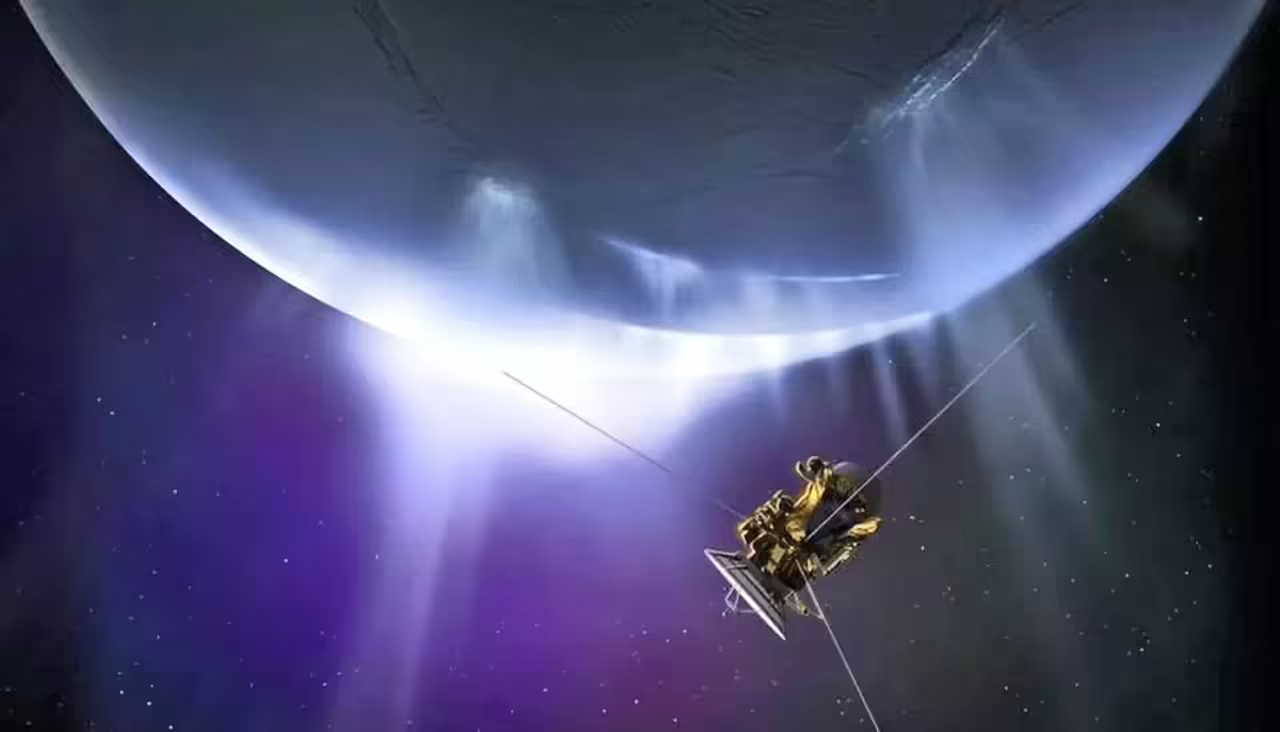
The Solar System, that vast and mysterious space that harbors an immense variety of celestial bodies, continues to surprise us with new discoveries. In a recent space expedition, scientists from the European Space Agency (ESA) have revealed an extraordinary phenomenon occurring on one of Saturn’s moons: the moon Enceladus, which spews water in unimaginable quantities into space.
Enceladus, one of Saturn’s 82 known moons, has been the subject of study for decades because of its peculiar appearance and unique characteristics. However, data collected by NASA and ESA’s Cassini-Huygens space mission revealed a fascinating secret: this small satellite is spewing water in large quantities from its polar regions.
The discovery of geological activity on Enceladus surprised scientists. Images captured by the Cassini probe revealed huge geysers of water rising from its icy surface and stretching for hundreds of kilometers into space. These geysers spew plumes of water vapor and ice particles at impressive speeds, forming a kind of ring around Saturn known as the “E-ring.”
Apart from water, scientists also detected the presence of complex organic molecules and volatile gases in the Enceladus geysers. These findings suggest the existence of a subsurface ocean beneath its surface with conditions conducive to microbial life. The combination of liquid water, organic molecules and energy sources could provide the necessary ingredients for the emergence and evolution of life as we know it.
The revelation of this amazing phenomenon has opened up a new field of study in space exploration and the search for life beyond Earth. Scientists are excited about the possibility of sending future missions to Enceladus to further investigate this moon and search for evidence of life in its subsurface oceans.
The discovery of Enceladus also raises intriguing questions about the habitability of other celestial bodies in our solar system and beyond. Could other satellites exist with subsurface oceans and conditions similar to Enceladus? What do these discoveries tell us about the possibilities of life on other planets and moons? These are some of the questions scientists hope to answer in the coming years as new missions are conducted and more data are collected.
The study of Enceladus and its water geysers also has implications beyond the search for extraterrestrial life. Water is a fundamental resource for life as we know it, and the possibility of finding it in abundance on other celestial bodies opens the door to new possibilities for space exploration and human colonization. If the presence of liquid water on Enceladus and other similar bodies is confirmed, we could use these resources to supply future space missions, establish scientific bases and even develop terraforming projects.
The availability of water in space could also have economic implications. Water is a scarce and valuable resource on Earth, and the possibility of extracting it from other sources could benefit humanity in terms of drinking water supply, food production and energy generation. In addition, water is composed of hydrogen and oxygen, two key elements for the development of fuels and propellants used in space propulsion.
The discovery of geological activity on Enceladus reminds us of the importance of space exploration and the continued advancement of science. As we investigate and discover more about our own Solar System, we expand our knowledge of the processes that shape the universe and move closer to answering fundamental questions about the origin of life and the existence of other living things in the cosmos.
Geyser plumes from this Saturn moon defy scientific expectations
Geyser plumes from Enceladus, Saturn’s moon that spews water in staggering quantities, have defied scientific expectations and opened new doors in our understanding of the solar system.
When the Cassini-Huygens probe began exploring Saturn and its moons in 2004, scientists expected to find a cold, frozen world. However, they were perplexed to discover active geysers on the moon Enceladus. These geysers spew water in the form of steam and ice particles from its icy surface into space, creating a spectacular display of geological activity.
What makes this phenomenon even more intriguing is the amount of water that is spewed out. Enceladus’ geysers spew water in staggering quantities, spewing plumes of water vapor and ice particles as high as 500 kilometers into space. This is a significant amount of water and suggests the presence of a massive subsurface ocean beneath the moon’s surface.
This revelation challenges scientists’ previous expectations about icy moons. Until the discovery of Enceladus, frozen moons were believed to be geologically dead bodies with no activity. However, the presence of geysers and geological activity on Enceladus indicate otherwise and raise many fascinating questions.
One of the most pressing questions is: what is driving this geological activity on Enceladus? Scientists believe that the heat generated by Saturn’s tidal forces, as well as gravitational interaction with other moons, may be generating enough energy to keep the subsurface ocean in a liquid state and trigger geyser activity.
In addition, the discovery of complex organic molecules and volatile gases in Enceladus’ geysers has further increased interest in this moon. These organic molecules could be precursors to life and, combined with liquid water and energy sources, could create conditions conducive to the existence of microbial life forms.
The Enceladus geyser phenomenon has led to the planning of future space missions to further investigate this intriguing moon. NASA’s Europa Clipper mission, scheduled to launch in the 2020s, aims to study Jupiter’s moon Europa, which is also believed to have a subsurface ocean. This mission could provide valuable information about subsurface oceans on icy moons and increase our knowledge about the habitability of these worlds.
Exploring the limits of science: geyser plumes that could fill a swimming pool in hours
Exploration of Saturn’s moon Enceladus has led to amazing discoveries that challenge the limits of science. One of the most fascinating phenomena is the presence of geyser plumes that spew water in such vast quantities that they could fill a swimming pool in a matter of hours.
Enceladus’ geysers originate from cracks in its icy surface, spewing water in the form of steam and ice particles to impressive heights. Scientists estimate that these geysers can reach heights of up to 500 kilometers above the moon, which is approximately three times the distance between Earth and the International Space Station.
The amount of water ejected by these geysers is simply extraordinary. According to measurements made by NASA and ESA’s Cassini-Huygens probe, the Enceladus geysers expel about 200 kilograms of water per second. This figure may not seem impressive at first, but when considered over time, it becomes truly staggering.
If we extrapolate this emission rate over a longer period of time, we can better understand the magnitude of the phenomenon. If we assume a constant rate of 200 kilograms per second, Enceladus’ geysers could fill a standard-sized Olympic-sized swimming pool, containing approximately 2.5 million liters of water, in just a few hours. This figure gives us an idea of the immensity of the quantities of water spewing from this small moon.
The question that immediately arises is: where does all this water come from? Scientists believe that Enceladus harbors a massive subsurface ocean beneath its icy surface. The heat generated by Saturn’s tidal forces, as well as gravitational interaction with other moons, could keep that ocean in a liquid state. Geysers are the result of the release of this water through cracks in the icy crust, creating this marvelous display of geological activity.
The discovery of Enceladus’ geysers has not only expanded our understanding of icy moons, but also raises interesting questions about the habitability of other celestial bodies in our solar system and beyond. The presence of liquid water, combined with complex organic molecules and energy sources, could provide the necessary conditions for the existence of microbial life forms. This has sparked the interest of scientists to further explore Enceladus and search for evidence of life on this fascinating moon.
Possibilities of extraterrestrial life
Discoveries of water on celestial bodies like Saturn’s moon Enceladus certainly increase the chances of finding extraterrestrial life in our solar system and beyond. Water is an essential ingredient for life as we know it on Earth, and its presence on other worlds is a key factor in determining their habitability.
The existence of liquid water on Enceladus suggests that there may be suitable conditions for microbial life in its subsurface ocean. Oceans, both on Earth and on other celestial bodies, are environments conducive to the emergence and evolution of life. Water acts as a solvent, allowing chemical reactions and the formation of complex biological structures. It also provides a stable environment for the protection of organisms against extreme conditions.
The discoveries of water on Enceladus also support the idea that subsurface oceans may be common on icy moons and other similar celestial bodies in our solar system. Moons such as Europa (Jupiter’s moon), Ganymede (also Jupiter’s moon) and Triton (Neptune’s moon) are some examples where the presence of subsurface oceans is suspected. These oceans could harbor conditions suitable for life, which increases the chances of finding extraterrestrial life forms in our own cosmic neighborhood.
In addition to celestial bodies in our solar system, discoveries of water on exoplanets also increase the chances of extraterrestrial life. The presence of water has been detected in the atmosphere of some exoplanets, suggesting the existence of oceans or bodies of liquid water on their surface. These exoplanets could harbor habitable conditions and be promising sites for the search for life.
It is important to note that while water is a fundamental requirement for life as we know it, it is not the only determining factor. Life also requires a source of energy, a suitable atmosphere, complex chemistry, and a range of favorable environmental conditions. However, the discovery of water is a significant first step in the search for extraterrestrial life, as it provides a potentially habitable environment.







